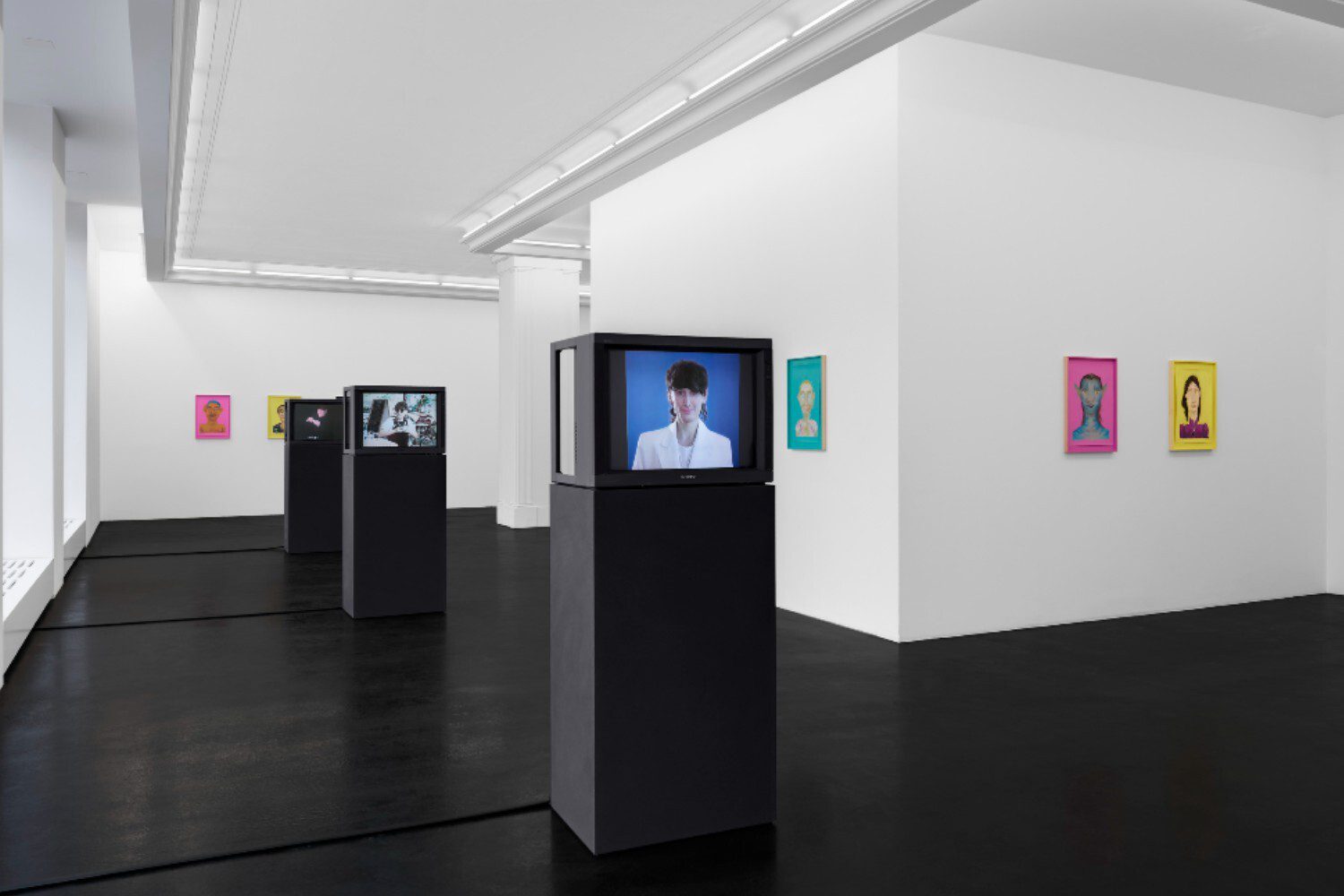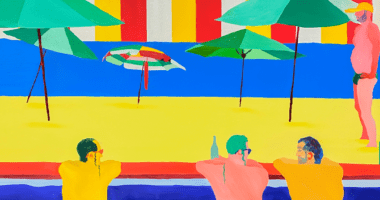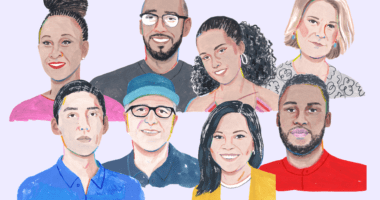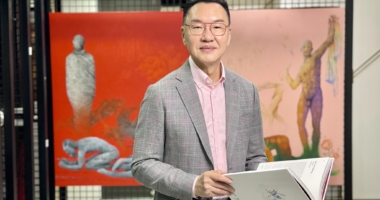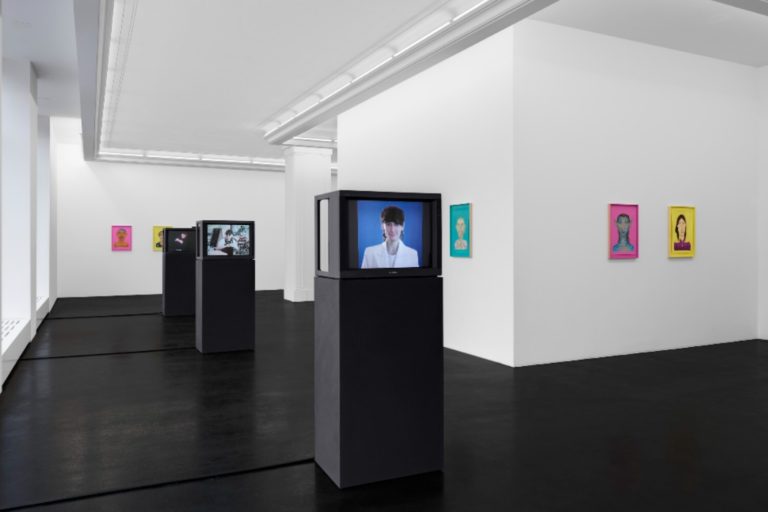
Installation view, “Manuel Solano: Portraits” at Peres Projects, Berlin, 2019. Courtesy of the artist and Peres Projects.
Some artwork subtly hints at its queer undertones. That’s not the case in Cajsa von Zeipel’s Post Me, Post You (2022), which was surrounded by visitors at Company Gallery’s booth at Frieze New York last month. Four lifelike human sculptures posed on a bed, bodies arched and heads thrown back mid-cavort, wearing little clothing but a variety of silicone appendages, head-mounted cameras, and even a Yeezy shoe.
It’s not new for an artwork to state its queer allusions so clearly. But as collectors of LGBTQIA+ art are becoming more numerous, and (in the West in particular) queer artists are becoming more visible in museum shows, galleries are an important part of the puzzle in supporting these artists. How are dealers working to represent the varied practices of LGBTQ artists today?
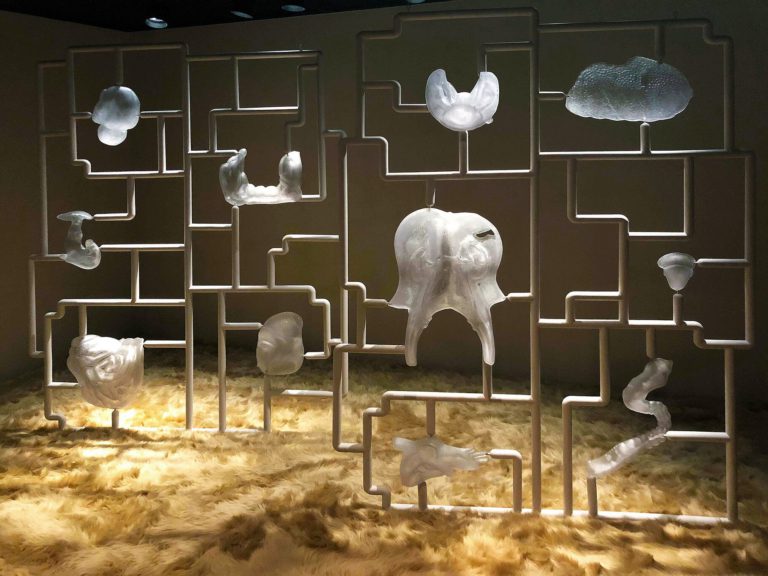
Installation view, Jes Fan, Visible Woman, 2018, at Empty Gallery, Hong Kong. Courtesy of the artist and Empty Gallery.
“There’s always been a queer element to the gallery’s program, but that’s never been the point of the gallery,” said Nick Königsknecht, director at Peres Projects. For him, it’s just a natural part of showing an artist’s work: “I think that there has to be an authentic belief in the work beyond whatever demographic that person is representing.” It also, he said, depends on the artist. For some, like Manuel Solano (who entitled one series “Blind Transgender with AIDS,” after their own personal experiences), the queer aspect of their identity is central to the work. For others, Königsknecht said, it’s less relevant in conversations with collectors.
Given the gallery’s location in less commercially focused locations (initially San Francisco, then Berlin, and more recently, Seoul and Milan), international art fairs have always been important selling opportunities for Peres Projects. When it comes to showing work by queer artists at these events that is confrontational, or political, Königskecht sees it as the gallery’s role to adequately provide the collector or art fair visitor with enough information to help them appreciate the work. “I see us as amplifiers,” he said. “The burden is on us to present the work in a way that is understandable, and relatable to a large audience,” he continued. This also goes for shows outside of Europe, including places where LGBTQIA+ communities are less visible. “We never go where we’re not invited, so if we’re going somewhere, they’re expecting us to bring our program,” he said.
While there are some collectors that may be less familiar with queer themes, others choose to collect solely LGBTQIA+ work, which can be a way for buyers to streamline their interests, said Königsknecht. “What’s interesting about collecting is that you start realizing very quickly that you need focus,” he said. “A lot of people set up rules for themselves about what it is that they want to collect.”
Gemma Rolls-Bentley, a London-based curator, collector, and consultant focusing on queer art, finds this kind of work the most appealing to her because it’s a way of seeing her own life in art: “I think that most people really resonate with work in which they see themselves reflected, in a way that respects and honors the people in it, but also kind of just pays tribute to the queer experience,” she said. Though some of this work is figurative (she owns a painting of a couple kissing by Sola Olulode, for example), it doesn’t have to be. She also owns two repurposed window works by Jesse Darling, she explained. “Maybe that artist wasn’t specifically thinking about their queer identity when they were making that work, but I think it all plays in.”
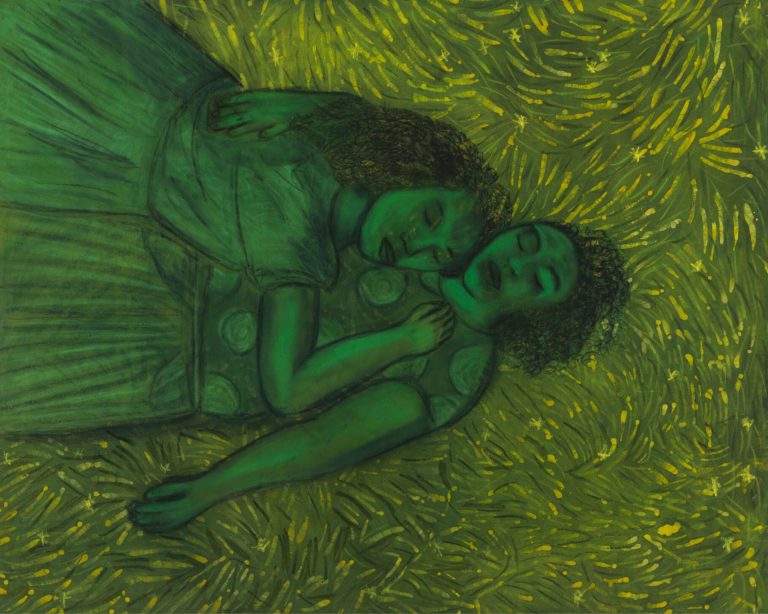
Sola Olulode, Laying In The Grass VI , 2021. Courtesy of Lawrie Shabibi.
During the time that Rolls-Bentley has been working in this area, she’s noticed a positive trend in visibility for queer artists. She found there was a particular art-world response to some key milestones of gay liberation in the U.S. and U.K. in the last few years (in 2017, it was 50 years since the U.K. decriminalized homosexuality; 2019 was the 50th anniversary of the Stonewall Riots). “Our voices are getting louder,” she said, noting that when she recently curated a collection of LGBTQIA+ art for Brighton’s just-opened Soho House, she found that galleries were clamoring to be included.
Similarly, Company’s Sophie Mörner, proprietor of that attention-grabbing Cajsa von Zeipel booth, has also noticed changes. When she first started the gallery in 2015, “there was more judgment,” she said. Today, she finds that there’s “more acceptance or curiosity.” Though she represents plenty of queer artists, this was never an explicit intention, she explained: “For me, it was very important to not be pigeonholed into being a queer gallery… it’s very important to stay fluid… When you embody something and live it in such a deep way, as I do, as a lesbian in the world, then it’s just who you are.”
There are still barriers, however. When Jonathan Lyndon Chase, for example, showed in Shanghai recently, they had to find paintings “without any kind of sex in them,” Mörner said. When faced with these challenges, as a gallerist “you just have to keep pushing.” For her, the next step will be taking Company’s boundary-pushing works to an Asian art fair for the first time. “I think that will be really incredible,” she said.
One collector deeply familiar with these challenges is Patrick Sun, founder of the Sunpride Foundation, a collection of Asian LGBTQIA+ art that preserves and exhibits works in museums across the continent. “When we approach an artwork, our angle is probably quite different from other collectors. My personal liking is less important,” he said. He is also committed to collecting works in diverse media (one is even an NFT), though most of the art he encounters in this field is painting and sculpture.
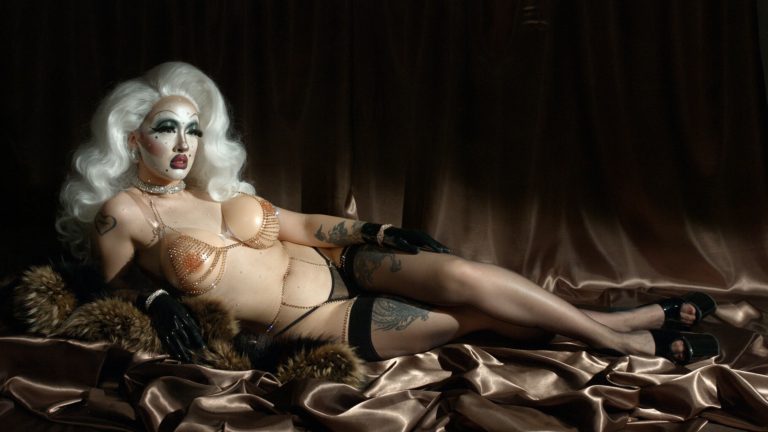
Still from Sin Wai Kin, Tell me everything you saw, and what you think it means, 2018. Courtesy of the artist, Blindspot Gallery, and Sunpride Foundation.
Of course, many artists (especially those with less famous biographies) may not be known for their queer identity, meaning Sun has to do careful research to find artworks that fit his mission. “At the beginning, I felt like a detective. I had to explore the background to find out the story behind it, but things have become easier,” he said. “I think I’ve been very lucky to enter the collecting market at a time when this is a very important topic.” Now, as an established art collector of work by LGBTQIA+ artists, he finds that galleries and curators put him in touch with suitable artists for his collection. He name-checked Hong Kong–based Empty Gallery and Kiang Malingue, as well as Esther Schipper, P.P.O.W, and David Zwirner as dealers that have been helpful in spotlighting queer artists. “I think most galleries are very aware of this topic, and certainly do not shy away from what we hope to do,” he said.
Even so, the politics of queer art in Asia have changed since Sun established the collection in 2014. He pointed to the work of Dinh Q. Lê, a Vietnamese American artist working with cascading photographs, woven into hanging sculptures, whose recent series “Skin on Skin” featured gay pornography, as a comment on Vietnam’s policy on sexually explicit material. “Even 10 years ago, it would not be possible,” said Sun. “The printer wouldn’t print it.”
Even today, there is still a range of attitudes towards LGBTQIA+ rights within Asia: While Taiwan and Thailand have bans on anti-gay discrimination, some countries such as Brunei and Qatar still make homosexuality punishable by death. For this reason, Sun has added several works from artists from more repressive countries into the collection under pseudonyms, preserving their significance, even without real names attached: “Having that participation is important,” he said.
This article was written by Josie Thaddeus-Johns.
